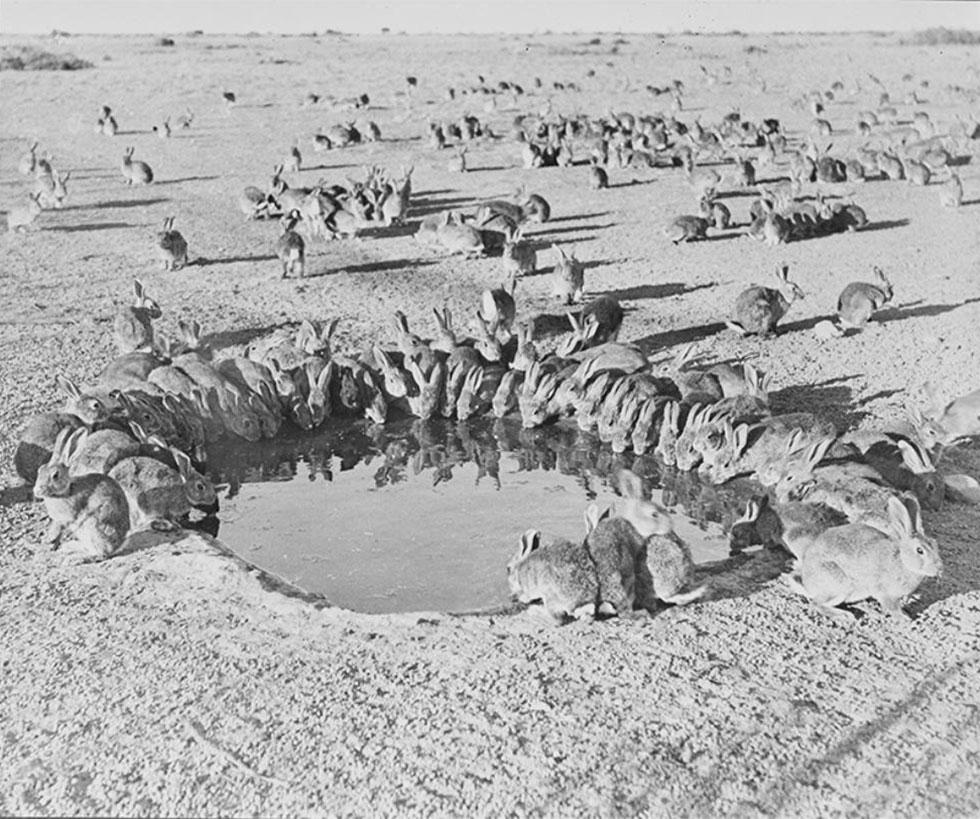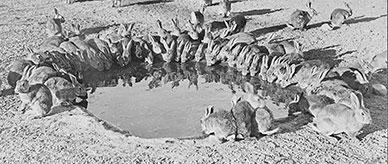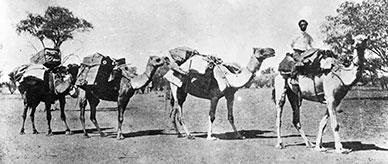


About this record
This black-and-white photograph, taken in 1938, shows a group of rabbits at Wardang Island, South Australia. These rabbits were part of a research trial of biological ways to control the rabbit population. Trials of the myxomatosis virus were conducted between 1936 and 1943 by Dr Lionel Bull and MW ‘Bill’ Mules from the Council for Scientific and Industrial Research (CSIR). Several of the rabbits are drinking at a waterhole and many more can be seen in the trial area, which was enclosed by a double fence.
Educational value
- A small group of domesticated rabbits were brought to Australia on the First Fleet in 1788 to help to provide food in the new colony. However, when English settler Thomas Austin imported 24 European wild rabbits in 1859, these rabbits quickly adapted to the Australian environment and rabbit numbers grew. Rabbits spread quickly and colonial settlers began to use them for food and clothing as well as for hunting.
- Rabbits soon became a pest in Australia. As we can see in this photograph, they ate not only plants but also the plant seeds, meaning that there were no seeds left to grow into new plants. In time, this led to bare earth and erosion. Colonial settlers found that the rabbits ruined areas they had previously used as pasture for sheep and cattle, and many native animals disappeared from their natural habitats.
- As rabbits spread from the east coast of Australia towards the west, colonists tried to stop them by trapping, poisoning and digging up the warrens. From 1902 the Western Australian Government built a series of fences (known as ‘rabbit-proof’ fences) in an unsuccessful attempt to stop the rabbits from spreading.
- From 1937 to 1943 the Council for Scientific and Industrial Research (CSIR) (later the Commonwealth Scientific and Industrial Research Organisation—the CSIRO) conducted experiments to find biological ways to control the rabbit population. Myxomatosis was the first successful virus to be used. The trials at Wardang Island shown in this photograph involved injecting some rabbits with the myxomatosis virus and placing them in an enclosure with several hundred other rabbits, then recording the progress of the disease.
- By 1950 myxomatosis was used widely in Australia. The infection killed almost all the rabbits that caught it and, in the first two years of its use, myxomatosis reduced the rabbit population from 600 million to 100 million. However, rabbits became resistant to the virus over time, so myxomatosis could not be a permanent solution to the rabbit problem. In the 1990s the Commonwealth Scientific and Industrial Research Organisation (the CSIRO) successfully used a new virus—Rabbit Calicivirus Disease (RCD)—to reduce rabbit numbers.
- Rabbits continue to be a pest in the Australian environment. Since being introduced over two centuries ago they have had a catastrophic impact on the natural environment. They have also had negative consequences for both agricultural and native animals by destroying their food sources.
Related themes
Need help with your research?
Learn how to interpret primary sources, use our collection and more.



